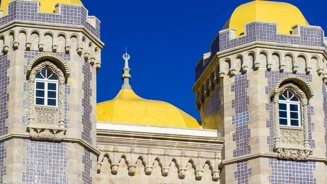Revision of the Cabaças Stairway and Smoking Room roofs, and conservation of interior coatings in the Pena National Palace

At the time when the Pena Palace was inhabited by members of the Portuguese royal family, guests entered through the Cabaças (Gourds) Entrance, located in the tunnel under the Triton, on the left side. Going up the Cabaças Stairway, a spiral staircase starting behind the door bearing the same name, the guests were welcomed in the social and entertainment rooms in the public area of the Palace: the Great Hall (then called the Billiard Room) and the Smoking Room, located on either side of the Entrance Room.
As of June 2022, these spaces are subject to conservation and restoration works, with an expected duration of 6 months. Integrated in the conservation and enhancement strategy of the National Palace of Pena, this intervention follows the methodologies defined in the monument's Heritage Management plan, which encompasses regular conservation and maintenance processes for all different types of covering existing in the palace, promoting the sustainable conservation of this important building in the long term.
The fundamental objective of the project is to improve the state of conservation of the palace, interrupting the alterations to the materials and contributing to their safeguarding for future memory, while enhancing their historical and aesthetic values.
Contemplated works
This intervention involves maintenance actions in the tile covering of the golden domes of the Smoking Room and the Cabaças Stairway, which are very exposed to adverse weather conditions. It encompasses the careful cleaning of the glazed surfaces, the revision of joints to prevent infiltrations, and the stabilization of the tile covering. The gutters and other elements in the roof are also to be revised, as well as the iron and glass window frames, which are essential elements for the preservation of the palace's interior.
Inside the palace, works consist on the conservation of the stucco coating and other elements of the Entrance Room, as well as the conservation of the decorative painting of the Cabaças Stairway. The state of conservation of these decorative elements exhibits surface deposits, saline efflorescences, the disintegration of mortar and stucco, occasional gaps, and slabs in the process of detachment. These alterations will thus be stabilized, with a view to improving the interpretation of these spaces and safeguarding the authenticity and historical memory of the National Palace of Pena.
About the intervention objects
The coatings are unique memories - both material and immaterial - of the construction technologies of the different phases of the building, revealing the different tastes and architectural polychromatic expressions, testimonies of the passage of time.
The tiles on the golden domes of the Palace of Pena were produced by the well-known Fábrica Roseira, which was active during the 19th century and was also responsible for the tiles lining the façades - with a neo-Moorish pattern -, and the ones in the Dining Room and the Bathroom of the Secretary.
The Entrance Room was completed in 1859, with the application of decoration in painting, stucco with a basketwork pattern and limestone framing, on the doors and in the niches. The cream and red lioz flooring, with a checkered pattern, is also part of the original decoration.
The Cabaças Stairway features decorative painting with plant motifs, finished with moldings and other architectural decorative elements in trompe l’oeil, all executed in dry lime techniques.
Once the conservation and restoration work in the Entrance Room of the Palace of Pena has been completed, this compartment will also see a new museology project that will provide the historical reconstruction of its ambiance at the time of the royal family.
Objects that were there in the period of King Ferdinand II will be returned to this room, such as an 18th century aquarium, produced at the Real Fábrica do Rato (Lisbon) and a pair of vases by the renowned modeler Jacob Petit (1797-1868, Paris) which will recover the decorative function they once had, upon returning to the place for which they were acquired by the builder of Pena. The carved oak chandelier that was also in this room, and which was ordered in 1866 by King Ferdinand II to the company Barbosa e Costa, was located by the conservators of the National Palace of Pena in the reserves of the National Palace of Ajuda, in Lisboa. Having been restored, it will also be returned to its rightful place. A dark green curtain with golden trimmings will also be reconstituted, whose careful commission to the same house Barbosa e Costa, in 1866, attests to the visual impact intended by King Ferdinand II for this guests entrance to the palace.
